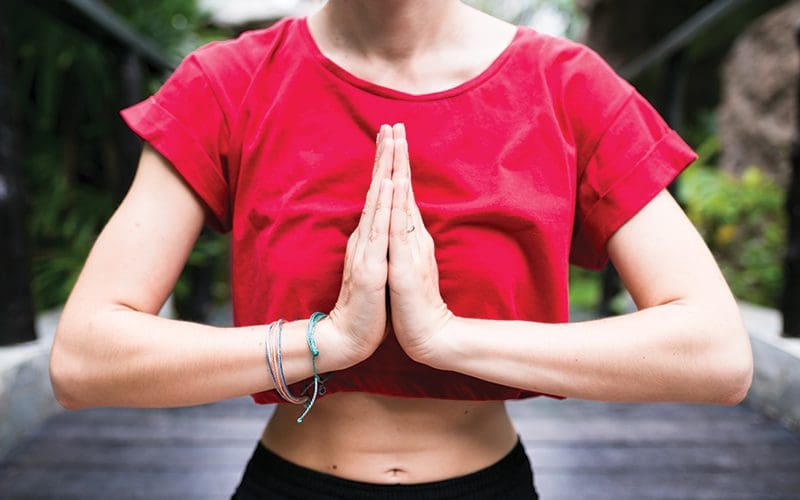
Mudras: In your Own Hands
Anjali mudra is used as a posture of composure, of returning to one’s heart, whether you are greeting someone or saying goodbye, initiating or completing an action. As you bring your hands together at your center, you are literally connecting the right and left hemispheres of your brain.
Mudra is a sanskrit word translated as “seal,” “closure” or “gesture.” A mudra may involve the whole body or be a simple hand position, symbolic in different cultures to communicate a feeling.
My focus here is on hasta mudras, which are hand gestures in yoga. For example, drawing together your palms at the heart is a familiar gesture perceived as a posture of prayer. Most people tend to use this gesture intuitively to show respect or gratefulness.
Mudras are simple
to perform by
yourself or guided.
We routinely express ourselves through hand gestures in everyday life. For example, we connect the tip of our index finger to the tip of our thumb, leaving our other fingers straight, to indicate something is “OK,” or we raise our hand up to signal “stop”.
There are many theories about how and why mudras work. Investigators have sought to understand the energetic, emotional and physical impact on practitioners, depending on where pressure is placed on the hand. Some theories are influenced by alternative branches of medicine such as reflexology, acupuncture and Ayurveda, a holistic healing approach based on mind-body connectedness.
Other theories about mudras are supported by scientific studies of the brain-body connection. Not only is one of our brain’s vital functions to control the movement of our body, but moving our body in different ways has a remarkable effect on our brain. It can enhance neuroplasticity — the brain’s ability to reorganize or “rewire” itself through new neural connections, or neurogenesis — the formation of neurons from neural stem cells.
Yoga instructors complement their practice with mudras, and they are also used in other traditions such as Jiu-Jitsu, Aikido, Tai Chi and Jin Shin Jyutsu. This opens up a whole avenue of research from the perspective of yogism.
Hasta mudras in yoga allow us to channel the energy created by our postures and conscious breathing to the chakras, to the mind and to whatever part of ourselves need transformation. It helps us attain many objectives for spiritual elevation if that is part of our intention in yoga practice, as well as physical and emotional healing.
Mudras are simple to perform by yourself or guided. Yet, they are very powerful in helping release or awaken blocked energy from your body.
We are moving from the age of information to the age of intuition. Take this knowledge about mudras and their effect on your body. Let it sink in your intellect and be digested by your intuitive self.
Yoga Terms
Hasta: Hand
Chakra: From the Sanskrit word meaning wheel, cycle and circle. Responding to both psychic and physiological functions, chakras are directly linked to mental, physical, and spiritual attributes.
Cover Story – Costa Rica is the Happiest Country in the World… Why?
Costa Rican Army Abolished: One more reason for happiness?
Feature Article – Living longer in Costat Rica Blue Zone
Costa Rica Yoga and Wellness Retreats
Yogapedia – Vrksasana: Tree Pose
Natural Medicine – CBD Oil: Nature’s Miracle Cure?
Mindfulness: Natural High: Benefits of Nature
Psychological Well Being – Counseling Help in Costa Rica
Eat Well: Costa Rica Superfoods – Nutrient Dense Food
Costa Rica Medical Tourism
Costa Rica Dental Tourism: Veneers – Reason to Smile
Ecotourism in Costa Rica: Sustainable Tourism
Ecotourism Pioneer: Rafael Gallo – Ríos Tropicales
The Osa Peninsula
Ecotourist Road Trip: Sarapiquí
Ecolodges in Costa Rica
Caminos de Osa: Tourism that is helping Costa Ricans
CST Being Green Matters to Diamante Eco-Adventure Park
Grow Sustainably, Build & Live Sustainably in Costa Rica
Behind the Image: Photography as Ecotourism
Building Green and Prove it in Costa Rica
Costa Rica Sustainable Development: Ever Greener
Costa Rica’s indigenous Communities and Indigenous Tribes
